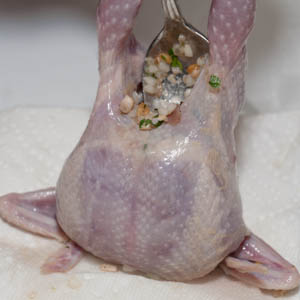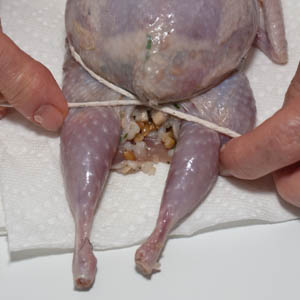Roasted Stuffed Quail for Two with Madeira Sauce

introduction
One of us comes from a family where wild pheasant was served sliced alongside roast turkey at the Thanksgiving table. Since I (Kay) fancied dark meat as a child, it was to my intense dismay when I selected poorly and ended up with stringy, funny-tasting meat riddled with buckshot. Not a great introduction to game.
What a surprise, then, to discover little birds that taste like something reminiscent of a Carolina autumn. Crisp, succulent roasted fowl and woodland flavors echoed in the stuffing of Carolina Gold Rice Grits and Farro Piccolo and favored with a demi glace fortified by Madeira, which represents mankind’s highest form of grape artisanship. This dish honors the flavor legacy of grapes and quail, ancient and modern at once. It is a primordial pairing.
If you are not familiar with how much everyone hunts in the South, you might not know that what is hunted is always consumed (no trophy hunting allowed in this neck of the woods). Or that quail, like oysters, are considered finger food, just as is anything easily taken in hand that comes from the wild. Pharaoh quail, the landrace breed we use here, have enough presence to make eating them a carnal adventure. When Southerners eat quail, they don’t count.
But you are welcome, of course, to celebrate with proper knife and fork, because quail, a very Southern charmer, can take on airs and civility, dress up, and sit down at the holiday table, too.
Cooking Remarks
We envision this dish as a romantic holiday dinner for two. But it just as easily serves four as a first course.
Manchester Farms, near Columbia, South Carolina, is well known for their consistently humane production of Pharaoh quail and for the nuanced game flavor their little birds carry. Manchester Farms’ chef clientele is strictly A-list, and though they could adopt an exclusive and elite attitude, they choose not to do so. We ordered European-style semi boneless birds—a snap to cook and serve.
We do a quick flavoring brine on the quail, which seasons them up very nicely.
equipment mise en place
For the stock reduction, you will need a large heavy-bottomed saucepan.
For prepping the quail, you will need a small saucepan, a shallow 9-inch glass baking dish, and a rimmed baking sheet fitted with a wire rack.
For preparing the stuffing and stuffing and cooking the quail, you will need two medium heavy-bottomed saucepans, a fine-mesh strainer, a glass pie pan or shallow baking dish, two small bowls and a medium bowl, a small heavy-bottomed skillet, butcher’s twine, a large ovenproof nonstick skillet, a pair of tongs, and an instant-read thermometer.
For the sauce, you will need a medium saucepan, a wooden spoon, a ladle, and a whisk.
-
for the stock reduction:
-
1quart (1 recipe) Rich Homemade Chicken Stock
-
½Turkish bay leaf
-
1allspice berry
-
-
for the quail:
-
4semi-boneless quail (see Cooking Remarks)
-
2cups spring or filtered water
-
1tablespoon packed light or dark brown sugar
-
2teaspoons fine sea salt
-
5garlic cloves, sliced
-
4strips of peel from 1 navel orange
-
1teaspoon crushed black peppercorns
-
1allspice berry
-
1tablespoon olive oil, to brown the quail
-
-
for the stuffing:
-
6cups spring or filtered water
-
2ounces (¼ cup) Anson Mills Carolina Gold Rice Grits
-
Fine sea salt
-
1ounce (2 tablespoons plus 1 generous teaspoon) Anson Mills Farro Piccolo
-
2teaspoons unsalted butter
-
2tablespoons dried currants
-
1tablespoon 5-year-old Malmsey Madeira
-
2ounces button mushrooms, wiped or brushed clean
-
1ounce (about ¼ cup) walnut halves
-
0.5ounce sliced pancetta, minced (3 tablespoons)
-
1large shallot, minced (3 tablespoons)
-
2tablespoons minced flat-leaf parsley
-
0.5ounce (about 1 tablespoon) lightly beaten egg whites
-
½teaspoon freshly ground black pepper
-
-
for the sauce:
-
3tablespoons unsalted butter
-
2tablespoons unbleached all-purpose flour
-
3tablespoons 5-year-old Malmsey Madeira
-
Fine sea salt and freshly ground black pepper
-
-
Make the stock reduction: Pour the chicken stock into a large heavy-bottomed saucepan. Add the bay and allspice, bring to a simmer over medium-high heat, and reduce the stock until it measures 1⅔ cups. Remove the pan from the heat, cover, and set it aside. (You will be using the stock reduction in both the stuffing and for the sauce.)
-
Brine the quail: Rinse and dry the quail. Remove any last feathers, if there are any, and trim away any fat. In a small saucepan, heat 1 cup of the water to just below a simmer. Add the sugar, salt, garlic, orange peel, peppercorns, and allspice and stir to dissolve the salt. Pour the liquid into a shallow 9-inch glass baking dish and stir in the remaining 1 cup of water. When the brine has cooled to room temperature, place the quail in the dish; they should be submerged. Transfer the baking dish to the refrigerator (no need to cover) and brine for 1½ hours (fig. 2.1).
-
Remove the quail from the brine and lay them on a wire rack set over a rimmed baking sheet pan. Slam the rack and baking sheet contraption on the counter several times to drive liquid from the quail, and then refrigerate uncovered for 1 hour or up to overnight.
-
Prepare the stuffing: While the quail brines and air-dries, adjust an oven rack to the middle position and heat the oven to 200 degrees. Measure 3 cups of water into each of two medium heavy-bottomed saucepans and bring both to a boil over medium-high heat. Add the rice grits and 2 teaspoons of salt to one saucepan, stir, and decrease the heat to medium-low to maintain a gentle simmer; add the farro and 2 teaspoons of salt to the second saucepan, stir, and decrease the heat to medium-low. Cook both uncovered. When the grits are almost tender but for a small center of hard starch, after 8 to 10 minutes of simmering, drain the grits in a fine-mesh strainer and flush them with cold water until cooled. Bounce the grits several times in the strainer to remove excess water, and then distribute them in a glass pie pan or shallow baking dish, dab with the butter, and dry in the oven, stirring occasionally, for 8 to 10 minutes. Let cool. When the farro is just barely tender, after 15 to 20 minutes of simmering, drain it in a fine-mesh strainer and flush with cold water until cooled. Bounce the farro in the strainer to remove excess water, and then set the strainer over a small bowl to allow the grain to drain further.
-
Turn the currants into a second small bowl, cover with the Madeira, and set aside. Trim the bottom of each mushroom high onto the mushroom cap itself, removing the stem and gills and exposing a solid disk of flesh (fig. 5.1). Slice each cap horizontally into thirds, and then crosshatch each slice into a diminutive brunoise dice (fig. 5.2); you should have about ½ cup. Set the mushrooms aside.
-
Place the walnuts in a small, heavy-bottomed skillet and toast over medium-low heat, stirring occasionally, until fragrant, about 10 minutes. Let cool slightly and rub the skins away between your palms. Chop the walnuts and set aside.
-
In the now-empty skillet, cook the pancetta over medium heat, stirring frequently, until the fat renders and the pancetta crisps, about 10 minutes. Add the shallot and sauté until soft and translucent, 5 to 7 minutes. Stir in the mushrooms and cook, stirring frequently, until the liquid they release has evaporated, 4 to 5 minutes. Add 2 tablespoons of the stock reduction and continue to cook until the stock reduces to a glaze. Add the walnuts and currants and sauté briefly. Turn the contents of the skillet into a medium bowl, add the rice grits and farro, and toss to combine. Season with salt to taste and the pepper. Stir in the parsley and egg whites (fig. 7.1) and let cool.
-
Stuff and truss the quail: Snip four 10-inch lengths of butcher’s twine. Working one quail at a time, set the birds on top of a triple thickness of paper towels. Bend each wing tip behind its back and stand the quail on its neck. Swab out the cavity with paper towels. Use a soupspoon to shovel stuffing into the quail (fig. 8.1) and press the stuffing evenly into the breast. Lay the bird on its back and position the butcher’s twine at the base of the neck (fig. 8.2). Tightly draw the twine down along either side of the breast (fig. 8.3), securing the wings in place. Pull the twine around and under the legs (fig. 8.4), twist the twine around the ankles, and tie. Trim away the excess twine (fig. 8.5).
-
With the oven rack still in the middle position, heat the oven to 350 degrees. Heat a large ovenproof nonstick skillet over medium-high heat for 5 minutes. Pour the olive oil into the skillet, swirl to coat the surface, and add the quail. Cook, turning the birds with tongs, until well browned on all sides, 10 to 15 minutes (fig. 9.1). Slide the skillet into the oven and roast the quail until the stuffing registers 150 degrees on an instant-read thermometer, about 5 minutes. Remove the skillet from the oven and let the quail repose in the skillet for 5 minutes (fig. 9.2).
-
Make the sauce: After putting skillet of the quail into the oven, bring the remaining stock reduction to a simmer over medium heat. Melt 2 tablespoons of the butter in a medium saucepan over medium heat. When it is bubbly, remove the pan from the heat and stir in the flour, and then return the pan to the burner. Cook the roux, stirring constantly, until golden, about 5 minutes. Ladle about ¼ cup of the hot stock into the roux, whisking vigorously to combine; gradually whisk in more stock in increasing amounts. Bring the sauce to a simmer and cook, skimming if necessary, until the sauce is smooth and glossy and thick enough to coat a spoon, about 10 minutes. Stir in the Madeira and whisk in the remaining 1 tablespoon of butter. Season to taste with salt and pepper.
-
To serve, snip and remove the twine from around the birds. Place each quail on a cutting board, breast up. With a sharp chef’s knife, cut the quail in half lengthwise, cleanly through the breast. Place two halves stuffing-side down on each of two dinner plates, and the other two halves stuffing-side up right beside (if serving as a first course, arrange only two halves—one stuffing-side down and one stuffing-side up—on each of four plates). Ladle with sauce and serve hot.
-
-
2.1

-
-
-
5.1

-
5.2

-
-
-
7.1

-
-
-
8.1

-
8.2

-
8.3

-
8.4

-
8.5

-
-
-
9.1

-
9.2

-
Step photographs by Kathy Rose